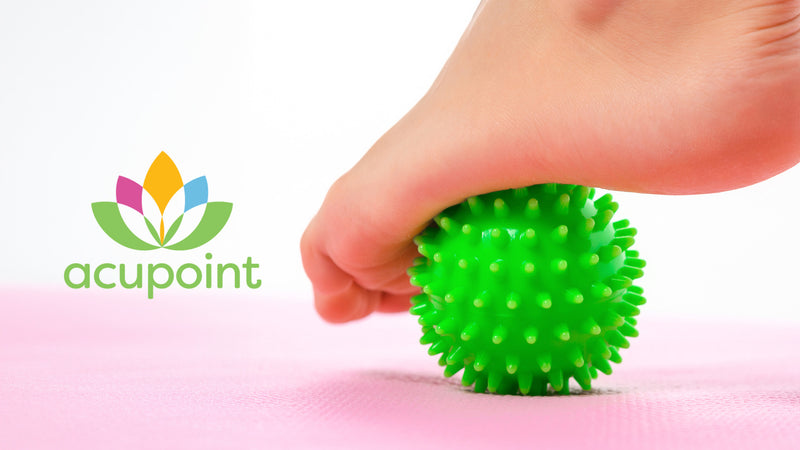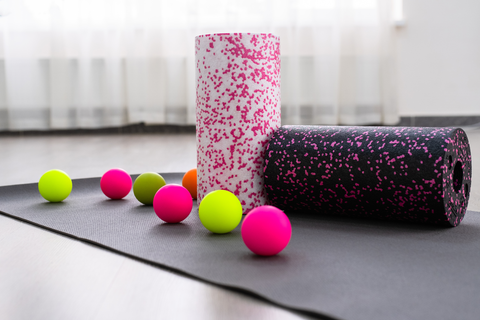Does your foot feel tight and sore or do you have stabbing pain in your feet every time you walk? If yes, you might have plantar fasciitis. This is basically the medical term that's characterized by inflammation of the plantar fascia, the tissue that connects the heel bone to the toes.
It's caused by many reasons such as long periods of standing or walking, especially on hard surfaces. This condition affects millions of people around the world every year. But the best part is that there are ways you can correct it.
In this blog, we'll show you how to use massage balls to treat this condition.
What's Plantar Fasciitis?
Credit: Envato Elements/ eakkachaih
Plantar fasciitis is a foot condition where the plantar fascia, the thick tissue that connects your heel to your toes, becomes inflamed. This often affects runners, people who are overweight, and those who wear shoes without proper support. The main symptom is a sharp pain in the bottom of the foot near the heel.
This pain is usually worse in the morning, after sitting or standing for long periods, or when doing activities like climbing stairs. The condition develops either gradually over time or suddenly after intense activity. It happens because of too much pressure on the plantar fascia ligament, leading to small tears in the tissue. Over time, repeated stress can irritate or inflame the fascia.
Why Use Massage Balls for Plantar Fasciitis?
Credit: Envato Elements/ LeylaCamomile
Using massage balls for plantar fasciitis can be very effective since they help stretch and massage the plantar fascia. This can reduce tension and pain in the foot. Massage balls work by applying focused pressure to the plantar fascia, which helps break up the adhesions and increase blood flow to the area. This increased circulation promotes healing and provides relief from pain.
Massage balls are especially useful because they are small and firm, allowing you to target the specific areas of your foot that are most affected. They are also convenient and easy to use at home, making them a practical tool for daily self-care. Regular use of a massage ball can help manage the symptoms of plantar fasciitis by keeping the fascia flexible and less prone to inflammation.
What Type of Massage Balls Should You Use?
Credit: Envato Elements/ habrovich
Look for options that are firm enough to apply pressure without collapsing. Rubber or silicone balls are ideal because they provide the right amount of firmness and grip to effectively massage the foot. The size of the massage ball also matters; a ball with a diameter of about 2 to 3 inches works well for most people, as it can easily target specific areas on the foot.
Some people prefer using a spiked massage ball as these can provide a more intense massage to help loosen the fascia and stimulate blood flow. However, if you find the spikes too painful, a smooth lacrosse ball can also be effective. If you don't have a massage ball at all, you can use a tennis ball.
How to Use a Massage Ball for Plantar Fasciitis
Credit: Envato Elements/ kolesnikovsergii
Here's how to use massage balls to self-massage your plantar fascia:
- Start by sitting in a comfortable chair where you can easily reach your foot.
- Put the massage ball under the foot that’s affected by plantar fasciitis.
- Gently press your foot down onto the ball to apply pressure. Adjust the pressure to what feels manageable without causing too much pain.
- Slowly roll the ball along the bottom of your foot using your body weight, moving from your toes to your heel and back. Focus on rolling through the arch and the heel areas where pain is typically concentrated.
- When you find a spot that’s particularly tender or painful, hold the ball in place there and apply gentle pressure for a few seconds to help release tension.
- Spend about 5 to 10 minutes rolling the ball under each foot. Adjust the duration based on how it feels and what your foot can tolerate.
- Use the massage ball multiple times throughout the day, especially first thing in the morning and again in the evening, to help stretch the plantar fascia and alleviate pain.
Additional Tips for Plantar Fasciitis Relief
Credit: Envato Elements/ macniak
In addition to using a massage ball, consider incorporating other strategies into your routine for optimal relief:
- Maintain a healthy weight. Extra weight can put more stress on your plantar fascia.
- Take breaks throughout the day, especially if you have to stand or walk for long periods. Give your feet time to rest can prevent further irritation.
- Consider anti-inflammatory medications like Nonsteroidal anti-inflammatory drugs (NSAIDs) like ibuprofen to reduce pain and inflammation.
- Give your feet a break by avoiding activities that worsen the pain. Apply ice packs to the affected area for 15-20 minutes several times a day to help reduce inflammation and alleviate discomfort.
- Include regular stretching exercises into your daily routine to help improve flexibility and reduce tension in the plantar fascia and calf muscles. Focus on gentle stretches for the feet, calves, and Achilles tendon.
- Wear shoes with good foot arch support and cushioning to help distribute pressure evenly across the foot and reduce strain on the plantar fascia. Avoid walking barefoot, especially on hard surfaces.
- Consider using orthotic inserts or arch supports in your shoes to provide additional support and stability for your feet.
- Use night splints to keep the plantar fascia stretched while you sleep. This can help prevent morning stiffness and alleviate pain when you first get out of bed.
How to Prevent Plantar Fasciitis
Credit: Envato Elements/ varyapigu
Here's how to prevent plantar fasciitis:
1) Wear Supportive Footwear
Invest in shoes that provide good arch support, cushioning, and shock absorption. Avoid wearing worn-out shoes or footwear with inadequate support, as they can increase your risk of developing foot problems.
2) Gradually Increase Activity
Avoid sudden increases in activity level, especially high-impact exercises like running or jumping. Gradually build up your exercise routine to give your feet and lower limbs time to adapt and strengthen gradually.
3) Stretch Regularly
Include stretching exercises for the feet, calves, and Achilles tendon into your daily routine. Stretching can help improve flexibility, reduce muscle tension, and prevent tightness in the plantar fascia.
4) Warm Up Properly
Before any physical activity, take the time to warm up properly. Start with gentle movements and dynamic stretches to prepare your muscles, tendons, and ligaments for more intense activity.
5) Cross-Train
Avoid overloading the same muscles and tissues repeatedly by including cross-training activities in your routine. Mix up your workouts to include a variety of low-impact exercises that target different muscle groups and reduce the risk of overuse injuries.
Alternative Therapies for Plantar Fasciitis Relief
Credit: Envato Elements/ towfiqu98
Here are some alternative therapies for plantar fasciitis:
1) Massage Therapy
Massage therapy involves manually manipulating the soft tissues of the foot to alleviate pain and tension in the plantar fascia. This is usually done by a professional massage therapist.
They target specific areas of the foot and apply techniques that help loosen tight muscles and increase blood flow to the affected area. Regular sessions can help maintain the flexibility of the plantar fascia, prevent further injuries, and support the healing process.
2) Acupuncture
This traditional Chinese medicine technique involves inserting thin needles into specific points on the body to relieve pain and improve bodily functions. For plantar fasciitis, acupuncture targets points along the foot and lower leg to help reduce inflammation and pain in the plantar fascia. It is believed that acupuncture stimulates the nervous system to release chemicals in the muscles, spinal cord, and brain, which may change the experience of pain or produce natural pain-relieving compounds.
Many people find this practice to be helpful in managing the discomfort associated with plantar fasciitis, especially when combined with other treatments such as stretching and proper footwear. Make sure that you always receive treatment from a licensed and experienced practitioner to ensure safety and effectiveness.
3) Shockwave Therapy
Shockwave therapy is a modern treatment option that uses sound waves to promote healing of the affected area. The therapy involves directing high-energy shockwaves at the plantar fascia to stimulate the body's natural healing processes. These shockwaves are thought to increase blood flow, stimulate cell regeneration, and dissolve calcium deposits that can contribute to pain.
It's typically recommended for cases of plantar fasciitis that haven't responded to more conventional treatments. It is a non-invasive procedure, usually conducted in a medical office, and can significantly reduce pain and inflammation in many patients. Treatments are usually spaced a week apart, with most patients experiencing relief after three to five sessions. As with any medical treatment, it's important to consult with a healthcare provider to determine if shockwave therapy is appropriate for your specific condition.
4) Physical Therapy
Physical therapy is usually done by a physical therapist who designs a personalized program that includes exercises to stretch and strengthen the plantar fascia, Achilles tendon, and lower leg muscles, which support the arch and improve foot function.
Therapy sessions may also involve the use of modalities like ultrasound, taping, or orthotic devices to reduce strain on the foot and alleviate pain. The therapist can also educate patients on proper foot alignment during walking and running and suggest ergonomic footwear. It's important to follow the exercises prescribed by the therapist consistently to achieve the best outcomes.
FAQs
Can plantar fasciitis go away on its own?
In many cases, plantar fasciitis can improve and eventually resolve with rest, stretching, and supportive footwear. However, it may take several weeks or even months for symptoms to fully subside.
Are there any exercises that can help with plantar fasciitis?
Yes, there are several exercises that can help relieve symptoms of plantar fasciitis by stretching and strengthening the muscles and tissues of the foot. Some common exercises include calf stretches, towel stretches, and plantar fascia stretches. However, it's important to consult with a healthcare professional or physical therapist before starting any new exercise regimen.
Can I still exercise if I have plantar fasciitis?
While it's important to rest and avoid activities that aggravate the condition during the acute phase of plantar fasciitis, many people find that they can still engage in low-impact exercises such as swimming, cycling, or using an elliptical machine. It's essential to listen to your body and avoid activities that cause pain or discomfort.
Are there any lifestyle changes that can help prevent plantar fasciitis?
Maintaining a healthy weight, wearing supportive footwear, avoiding prolonged periods of standing or walking on hard surfaces, and including deep tissue massage exercises for the feet and lower legs in your routine can help reduce the risk of developing plantar fasciitis.
When should I see a doctor for plantar fasciitis?
If you experience persistent or severe heel pain, difficulty walking or bearing weight on the affected foot, or if your symptoms do not improve with conservative treatments, it's important to consult with a healthcare professional. They can evaluate your condition, provide a proper diagnosis, and recommend appropriate treatment options.
Summary
Using a massage ball for plantar fasciitis can be an effective way to manage pain and promote healing. By following the simple steps outlined in this guide and incorporating additional self-care measures, you can find relief from plantar fasciitis and get back to enjoying your daily activities with greater comfort and ease.
Struggling with plantar fasciitis pain? Check out Acupoint massage balls. These specially designed tools can provide targeted relief to help you manage discomfort and promote healing. Whether you're dealing with mild discomfort or chronic foot pain, Acupoint massage balls can help you find relief. Shop with us today.




















